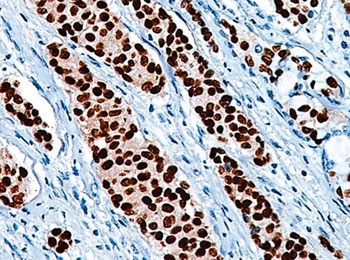Ordering Selective Breast Biomarker Tests Saves Health Care Dollars
By LabMedica International staff writers
Posted on 13 Jul 2015
Pathologists traditionally have tested for the biomarkers estrogen receptor (ER), progesterone receptor (PR) and human epidermal growth factor receptor 2 (Her2) on breast cancers in excisional biopsy specimens, when a surgeon removes all or a large portion of the tumor, to help guide drug treatment. Posted on 13 Jul 2015
Some experts question the routine use of core biopsy marker testing as many patients do not receive neoadjuvant chemotherapy, as many of the tumors detected today are too small to be eligible for the therapy. For patients who do not receive neoadjuvant chemotherapy, a negative biomarker test on their smaller core biopsy may not reflect the results in the larger excision specimen, because biomarkers may appear in some parts of the tumor but not in others.

Image: Histochemistry of progesterone receptor (PR) positive breast tumor (Photo courtesy of Biocare Medical).
Pathologists at Johns Hopkins University School of Medicine (Baltimore, MD, USA) studied records for 197 patients with breast cancer at their hospital who had so-called reflex biomarker testing done after small sample core needle biopsy. Among those patients, just 27 (13.6%) received chemotherapy before surgery, and eight (4%) showed no residual cancer during excisional biopsy. In those cases, the investigators noted, biomarker testing on the core biopsy was necessary. None of the remaining 162 patients received chemotherapy before surgery, and that treatment was considered only in a minority of those patients. Only five patients (3%) were seen by a radiation oncologist and medical oncologist before surgery, while only six (4%) were seen only by a medical oncologist.
On repeat testing after excisional biopsy, the scientists noted that three of the 18 cancers (17%) that were ER-negative in core biopsy samples were now found to be positive on excision, and one of the 24 (4%) cancers that was PR-negative in core biopsy samples was now positive on the excision. On repeat Her2 testing, one of the 42 cancers (2.4%) that was Her2-negative in the core biopsy was positive on the excision. Analyzing costs and benefits, the scientists found that if all negative core biopsy tests been repeated, the increased costs would potentially have been more than USD 100,000 or about USD 500 per patient. They estimated that if these costs were applied to the 230,000 new breast cancer cases diagnosed in the USA each year, they would total as much as USD117 million annually.
Pedram Argani, MD, a professor of pathology and oncology and senior author of the study said, “We suggest that clinical breast cancer teams consider stopping the practice of reflex testing of core needle biopsies, because the results typically do not guide the next step in therapy. A more logical, cost-effective approach would be to perform such testing only if chemotherapy before surgery is a serious consideration for that individual patient.” The study was published in the July, 2015 issue of the American Journal of Surgical Pathology.
Related Links:
Johns Hopkins University School of Medicine














